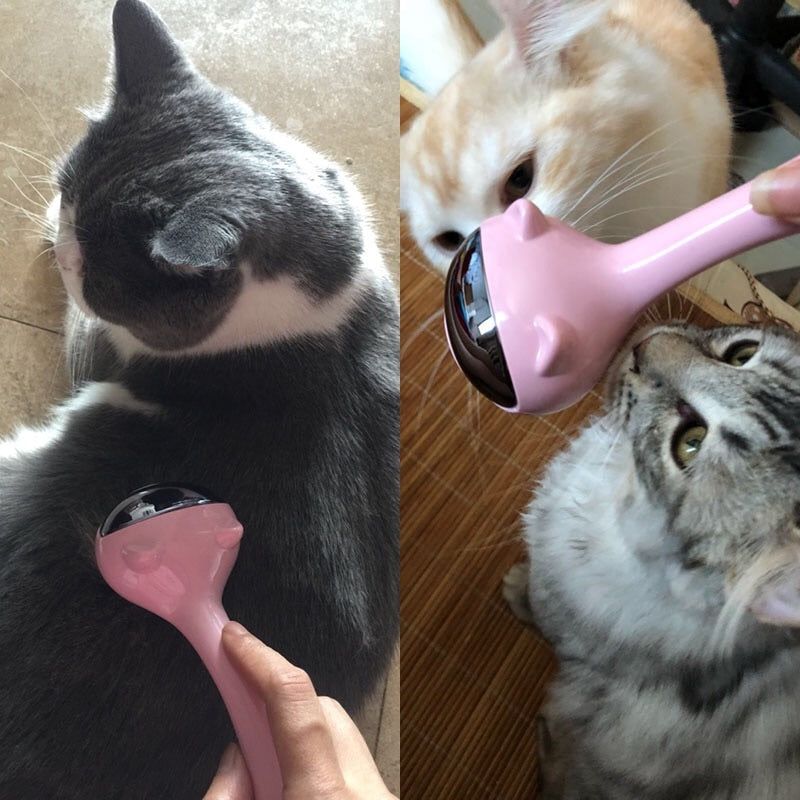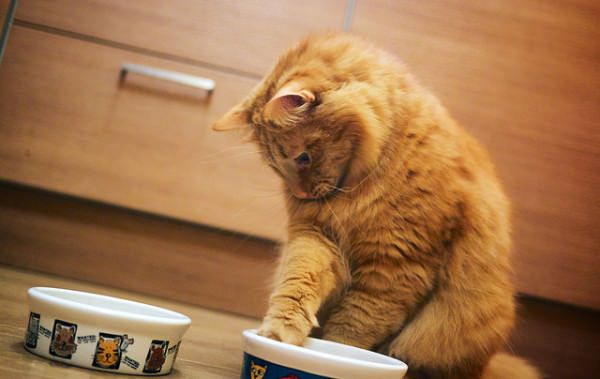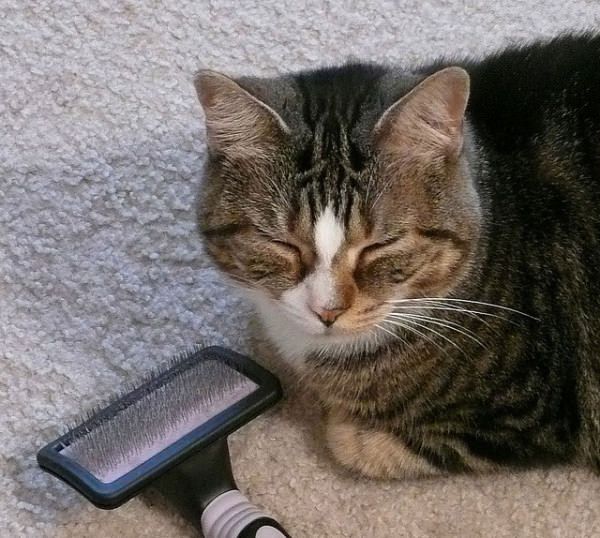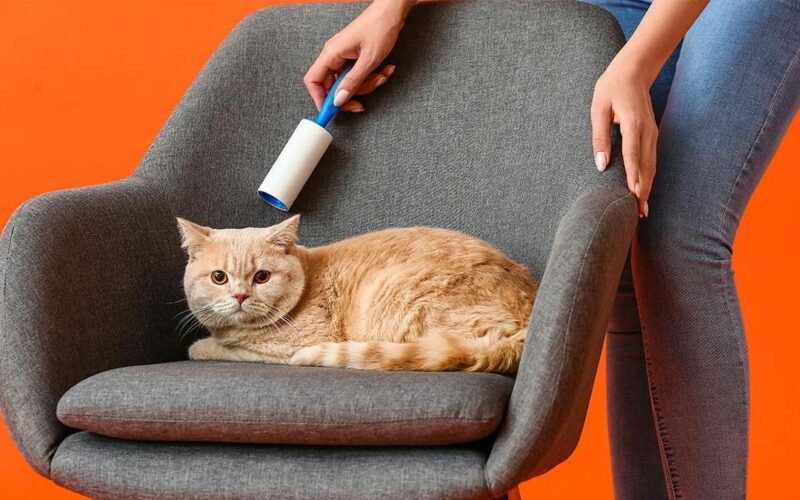If you’re a cat owner, shedding is likely a familiar issue you’ve had to deal with. But don’t worry! There are methods for controlling and reducing your cat’s shedding. Several strategies can help minimize cat shedding, from regular grooming to dietary adjustments.
Here is a list of 15 tips for controlling and reducing your cat’s shedding. These tips are easy to use and make a big difference in your home’s cat hair. We cover everything from brushing your cat regularly to creating a fur-friendly location.
But it’s not just about keeping your home hair-free. Shedding can also be a sign of an underlying health problem. Whether you are a new cat owner or a seasoned pro, this guide is an essential resource for keeping your home fur-free and your feline friend healthy.
With the help of these tips, you can reduce cat shedding and enjoy a happier, healthier cat.
#1 – Brush Your Cat

Cats are known for their grooming habits, but regularly brushing them can significantly affect how much cat hair is in your home.
Not only does it help minimize hairballs, but it also removes dirt, dead hair, and dander that contribute to unhealthy skin. By brushing your cat often, you can also prevent mats and tangles that a professional groomer would have to fix.
To reduce shedding, brush your cat for five to ten minutes at least once a week and more frequently for cats with long hair or heavy shedding. Remember to use a brush with soft bristles for short or medium hair and wire bristles or a specialized cat comb for long hair.
#2 – Train Your Cat To Get Used to Grooming
One of the best ways to reduce shedding is by getting your cat used to regular grooming.
However, this process may take some time and patience. Start by training your cat to tolerate grooming slowly and paying attention to their reactions and body language. Watch for signs such as a twitching tail or ear, and stop brushing if you notice them.
Praise the cat and give it a treat before trying again. With time and consistency, your cat will get used to grooming, and the amount of hair it sheds will decrease.
#3 – Bathe Your Cat
While most cats don’t enjoy baths, they can effectively reduce shedding. Bathing your cat every one to four weeks can help improve the condition of its skin and coat.
To begin, expose your cat to water in small increments and use a soap-free, oatmeal-based pet shampoo. Avoid getting water near the cat’s face, eyes, nose, and ears during the bath, and rinse the fur thoroughly.
After the bath, dry your cat off with a large towel. This will help reduce shedding and keep your cat clean and smelling fresh.
#4 – Use Cat Cleaning Products
Keeping your home free of cat hair can be daunting, but there are products specifically designed to make it easier.
Look for wipes or sprays that clean a cat’s fur without water. These products can be used in between baths or for cats that are difficult to handle. They can be used to remove loose hair, dirt, and dander, which will not only keep your cat looking clean but also reduce shedding.
These products are easy to use and can be found in most pet stores.
#5 – Improve Your Cat’s Diet
A well-balanced diet is essential for maintaining your cat’s overall health, including its coat.
Feeding your cat a diet high in omega-3 and omega-6 fatty acids can improve the condition of their coat and reduce shedding. These essential fatty acids are found in fish oil and flaxseed oil and can help to keep their fur shiny and healthy.
Consult with your veterinarian to determine the proper diet for your cat.
#6 – Use Vet-Recommended Supplements

In addition to diet changes, some dietary supplements may effectively reduce shedding.
Omega-3 and omega-6 fatty acids, biotin, and vitamin E are known to improve coat and skin health, which can lead to less shedding. These supplements can be found in most pet stores, added to your cat’s food, or given as a treat.
Before giving your cat any supplement, you should always talk to your vet to ensure it is safe.
#7 – Keep Cat Hydrated
Keeping your cat hydrated is essential for its overall health and can make its coat look and feel better.
Cats can be picky drinkers, so try different bowls, water sources, and flavors to encourage your cat to drink more. Dehydration can lead to dry skin, which can lead to more shedding, so ensure to provide your cat with fresh water at all times.
You can also add water to their food to increase their hydration.
#8 – Check Cat’s Health
Too much shedding can be caused by several health problems, like allergies, flea infestations, or problems with the thyroid.
Be aware of any illness in your cat, and consult your veterinarian if you suspect a health issue.
Regular check-ups and screenings can help identify and treat underlying health problems that may be causing excessive shedding.
#9 – Create A Cat-Friendly Space
Reducing shedding can also be achieved by providing your cat with private space.
Placing a cat tree or a blanket where they like to sleep can help minimize the spread of hair around the house. The blanket should be washed regularly or lint-rolled to remove the hair.
This controls shedding and helps your cat feel more comfortable and secure in their own space.
#10 – Keep Cat Indoors

Cats that are allowed to go outside are exposed to a more significant number of allergies and parasites, which can result in excessive shedding.
Keeping your cat indoors not only protects them from potential harm but also helps to reduce shedding.
Indoor cats have a more controlled environment and are less likely to be affected by external factors that can cause excessive shedding.
#11 – Exercise Your Cat
Regular exercise can help alleviate stress and improve overall health, which can reduce shedding.
Cats are naturally curious and active animals and need regular exercise to stay healthy and happy. Providing your cat with interactive toys, scratching posts, and regular playtime can help keep them engaged and reduce stress.
Regular exercise also helps to keep cats at a healthy weight, which can also reduce shedding.
#12 – Provide Scratching Posts
Scratching posts are not only helpful in maintaining the health of your cat’s claws, but they also help remove loose hair.
Cats naturally shed their hair as part of their grooming process, and scratching posts provide a natural way to remove that hair.
Having multiple scratching posts available in various locations around the house will give your cat plenty of opportunities to groom and reduce shedding.
#13 – Use Lint Rollers
Lint rollers are a quick and easy solution for removing hair from upholstery and garments.
These small, handheld rollers are covered in sticky paper that quickly picks up and removes hair and dander. They are perfect for quick clean-ups and can be used on furniture, clothing, and even car seats.
Lint rollers are a convenient and effective tool for keeping hair under control.
#14 – Vacuum Regularly
Regular vacuuming is essential for keeping your home free of hair and dander.
Carpets and upholstered furniture should be vacuumed regularly to help eliminate stray hair and dander. Not only does vacuuming get rid of hair, but it also gets rid of dirt, dust, and other allergens that can make asthma and allergies worse.
A high-efficiency particulate air (HEPA) filter vacuum can be especially good at catching pet dander, hair, and other allergens and getting rid of them from your home.
#15 – Clean with a Wet Cloth
A moist cloth can be a valuable tool for cleaning your cat and surfaces with hair on them.
This can help eliminate hair from surfaces and reduce the amount in the air. A damp cloth can gently wipe down your cat’s coat, removing loose hair and debris. Clean rags can also be used to wipe down surfaces such as furniture, floors, and walls, helping to remove hair and dander that can accumulate over time.
This method is a simple and effective way to keep hair under control.
Final Thoughts
In conclusion, managing shedding in cats is a very challenging task. With the right approach and effort, you can control your cat’s shedding and enjoy a cleaner and less hairy home. From regular grooming to dietary adjustments, there are a variety of methods that can be used to reduce shedding.
It’s important to remember that shedding is a natural part of a cat’s grooming process and cannot be stopped completely. However, by implementing these strategies and techniques, you can significantly reduce the amount of shedding and keep your home looking and feeling its best.
Of course, if you ever have concerns about your cat’s shedding, don’t hesitate to consult your veterinarian to rule out any potential health issues. It’s always best to be supported by a medical professional, especially when your pet’s health is on the line.
Further Reading






